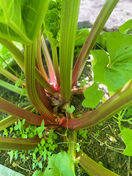
Rhubarb - A Versatile & Delicious Ingredient
Rhubarb is a plant that has a long history of medicinal use, dating back over 4,000 years. It's native to central and western Asia, and has been cultivated for medicinal purposes for centuries in ancient civilisations such as Egypt and Rome. In traditional Chinese medicine, rhubarb is still used as a digestive aid and to treat stomach aches and other digestive issues. It was not commonly used in cooking until the 18th century, when sugar became more widely available. It was originally used as a savoury ingredient, but as sugar became more widely available and affordable, it began to be used more often in sweet dishes such as pies and crumbles. Today, it's grown in many parts of the world and is used in a variety of dishes, both sweet and savoury.
In addition to being a tasty ingredient, rhubarb is also good for you. It's a good source of vitamin K and calcium, and it also contains some vitamin C and other minerals. Some research has suggested that rhubarb may have anti-inflammatory and antioxidant properties, and may be helpful in controlling blood sugar levels. However, it's important to note that the leaves of the rhubarb plant are toxic and should not be consumed. While the stalks of the plant are edible and can be cooked and eaten in a variety of dishes, the leaves contain oxalic acid, which can be harmful if ingested in large amounts. Oxalic acid is a naturally occurring compound that is found in a variety of plants, including rhubarb. It can cause symptoms such as nausea, vomiting, and difficulty breathing. Although the leaves of the rhubarb plant are toxic, they can still be used in other ways, such as an insect repellent or as a natural dye.
If you want to try growing your own organic rhubarb, it's a hardy perennial plant that can be grown in many parts of the world. It prefers a cool climate and well-draining soil, and should be fertilised with organic fertilisers such as compost or well-rotted manure. It's best to plant rhubarb in the autumn or early spring, and it should be watered regularly. The plant will produce edible stalks for many years, and the stalks can be harvested in the spring and early summer. Growing your own organic rhubarb allows you to have a fresh, homegrown supply of this tasty ingredient without the use of synthetic pesticides or fertilisers. To plant organic rhubarb, choose a sunny spot in your garden with well-draining soil. Dig a hole that is large enough to accommodate the root ball of your rhubarb plant, and place the plant in the hole, making sure that the crown (the point where the roots meet the stalk) is level with the soil surface. Backfill the hole with soil and water the plant well. Rhubarb plants are generally easy to care for, but they do require regular watering and occasional fertilising with organic fertilisers to keep them healthy. If the crown gets to big after a few years you can easily split it and make smaller rhubarb plants. This is done in the autumn.
In addition to being used in traditional dishes such as pies and crumbles, rhubarb can also be used in more unusual and creative ways. It can be blended into smoothies or made into jam or jelly. It can also be pickled or used as a flavour in cocktails and other beverages. Some people even use it to make homemade wine or beer. The tart and tangy flavour of rhubarb adds a unique twist to many different types of dishes and beverages. If you want to experiment with using rhubarb in your cooking, there are many possibilities to explore. Try using it in breads, muffins, or even cocktails for a unique twist on your favourite recipes.
Whether you are using it as a sweet or savoury ingredient, rhubarb is a versatile and delicious plant that is sure to add some flavour and nutrition to your dishes.




